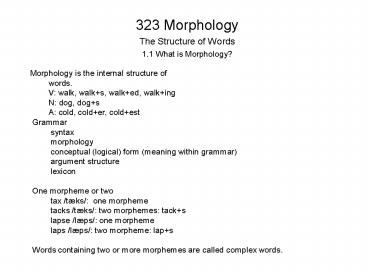323 Morphology - PowerPoint PPT Presentation
Title:
323 Morphology
Description:
Grammar syntax morphology conceptual ... in that it may refer to the study of morphology as a discipline or to the morphology of a specific language such as Sanskrit. – PowerPoint PPT presentation
Number of Views:95
Avg rating:3.0/5.0
Title: 323 Morphology
1
323 Morphology
- The Structure of Words
- 1.1 What is Morphology?
Morphology is the internal structure of words. V
walk, walks, walked, walking N dog, dogs A
cold, colder, coldest
Grammar syntax morphology conceptual (logical)
form (meaning within grammar) argument
structure lexicon One morpheme or two tax
/tæks/ one morpheme tacks /tæks/ two
morphemes tacks lapse /læps/ one
morpheme laps /læps/ two morpheme laps Words
containing two or more morphemes are called
complex words.
2
1.1 What is Morphology?
Definition 1 (Haspelmath) Morphology is the
systematic covariation in the form and meaning of
words. Definition 1 (DeArmond) Morphology is the
systematic covariation in the form, function and
sign of words. Form refers to whether a
morpheme is a root, base, stem, affix or
clitic. Function includes meaning. Some
morphemes have no meaning. Sign refers to the
phonological representation of a
morpheme. Definition 2 (Haspelmath
DeArmond) Morphology is the study of the
combination of morphemes to yield words This
definition does not work in all cases. The term
morphology is ambiguous in that it may refer to
the study of morphology as a discipline or to the
morphology of a specific language such as
Sanskrit.
3
1.2 Morphology in Different Languages
A particular language may express a certain
function through morphology the use of
inflectional or derivational affixes English
plural affix (suffix) book, books. Or
plurality may be expressed by a distinct
word Yoruba okùnrin man, àwon okùnrin
men. Actually, English uses both methods to form
the comparative and superlative of
adjectives red, redder, reddest (positive,
comparative, superlative). stupid, more stupid,
most stupid. Today, many younger speakers tend to
use both methods more redder (or sometimes more
red). Synthetic, Analytic and Isolating These
terms refer to the degree which affixes are
used Synthetic refers to systems where
affixation is used frequently to express
certain functions Russian, Czech, Sanskrit,
Latin, German, Japanese Analytic refers to
systems where affixation is modestly
used English, Dutch, Frisian, Swedish. Polysynt
hetic refers to systems where there is frequent
affixation and perhaps compounding and phrasal
incorporation Greenlandic Eskimo (Inuit),
Turkish, Salishan languages. Isolating
refers to
4
1.3 The Goals of Morphological Research
- The goal of morphological research is to describe
(determine the best analysis) and to explain the
morphological patterns of human languages. - Elegant description































